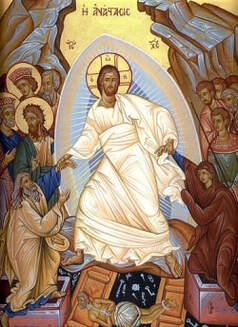
AFTER THE RESSURECTION
After the resurrection of Jesus, the apostles set out to spread the Word of Jesus Christ to the rest of the world. The early Gospel message was spread orally, probably Image Credit: By Surgun100 - Own work, Public Domain in Aramaic.
Image Source: commons.wikimedia.org/index.php ▲ There was no real. “organized” religion or church at that
time. Instead, there were enclaves of Jewish Christians who tended to develop their own interpretations and doctrines.
Christians in the 3rd-4th Century & Constantine - PowerPoint PPT Presentation
▼Image Souree: islideserve.com/zachary-dean/christians-3rd-4th
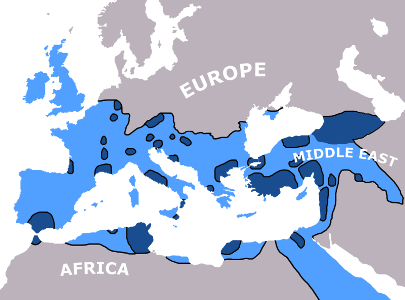
By then, there was a more formal structure which evolved from early Jewish-Christian communities, and variant Christian doctrines developed. Christianity grew apart from Judaism, creating its own identity.
In 325 AD, Roman Emperor Constantine the First called together a council of about 300 Christian bishops in the city of Nicaea, to develop a consensus regarding the issues that divided the leaders, including the name of the religion, and also the date upon which Easter (Ressurection Sunday) would be celebrated.
WHAT’S IN A NAME?
“Easter” is the English word for “Pascha” which is directly related to the Jewish Passover, the commemoration of the Jewish Exodus from Egypt.
▼ Image Source: christianbook.com/ecclesiastical-history-of-the-english-people/
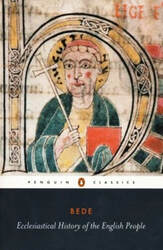
The word “Easter” appears in the 6th century’s “Ecclesiastical History of the English People” written by Saint Bede the Venerable. This text claims the word Easter derives from “Eostre (or Eostrae)”, the Anglo-Saxon goddess of spring and fertility. Other historians claim the name derives from a Latin phrase which, in plural, means dawn. The word dawn/alba became “eostarum” in German, a precursor to the English language.
Isn’t etymology fun?
WHAT’S IN A DATE?
Following the etymology of the name for this celebration is a piece of cake compared to figuring out the day to celebrate the Resurrection.
The calculation begins simply. The resurrection of Jesus from the dead is cited in the New Testament as having occurred on the third day after his burial following his crucifixion by the Romans, which occurred in 30 AD -- A piece of cake!
A five-part Russian Orthodox icon depicting the Easter story.
Eastern Orthodox Christians use a different computation for the date of Easter than the Western churches.
Image Source: commons.wikimedia.org/3200390 ▼
According to the Gospel of John, the resurrection of Jesus happened to fall on Saturday, not Friday. aethelmearcgazette.com/medieval-easter-traditions/
And why does Easter (aka Resurrection Sunday) fall on different dates in various parts of the world and among different denominations of Christianity? Eastern Orthodox Christians and Western Christians celebrate at different times because the west still goes by the old Julian calendar to set the date of Easter, even though we use the Gregorian calendar for fixed feasts like Christmas.
The controversy over when to celebrate Easter continued for years because of the differences between the Hebrew and Julian calendars and the way Passover is established in the Bible. Hebrew Calendar ▼ image source: pinterest.com/495958977703692715
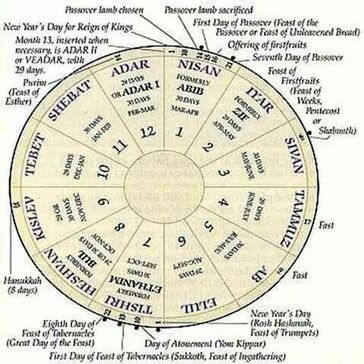
That was later modified under Augustus Caesar and used until The Gregorian calendar was introduced in 1582l. Over the years, that calendar has been refined to be more accurate, but not without more controversy and complications.
Today Easter “comes the first Sunday after the ecclesiastical full moon that occurs on or soonest after 21 March.” https://en.wikipedia.org/wiki/Easter
If that doesn’t clarify things, forget the calculations and look on the internet for the date.
EASTER IN THE MIDDLE AGES
The Easter celebrations are surprising similar to today’s practices, with a few major difference.
● Holy Week
Holy Week is the week between Palm Sunday and Easter. The three days before Easter — Maundy Thursday, Good Friday, and Holy Saturday — were called the Triduum. The people spent most of the day in almost-completely-dark churches for the services called Tenebrae. During this period, no one was allowed the Holy Eucharist.
While today Christians attended services on those days, they are not held in the dark. I guess they didn’t worry about public liability in those days.
● Sunrise Service
Easter Sunday began at dawn with the congregation gathering outside the church to sing hymns. Then the priest would lead them into the church for a joyful service, and the congregation received Holy Communion. At the end, the people would be dismissed in grace and forgiveness, and then enjoy a great feast.
In the twenty-first century, Easter celebrations often include going to church followed by a special meal, except that nowadays we haven’t been fasting for three days.
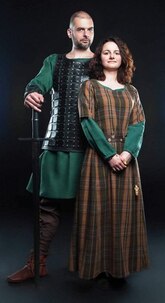
This was the time of year when people got new clothes. It was the custom that the local nobility had their new clothes made for them, and then passed their older clothes to the servants. The servants kept some and handed the rest to relatives, and so on. And if you were going to sew new clothes for yourself, this was the time of year to do it.
How often have you had new clothes for Easter? Maybe we don’t walk in the Easter Parade, but it’s often a good time to have something new to wear.
● The Big Feast
Following the Church services, there was a big feast. After eating only fish for forty days, the people were ready to party.
Feasts were a serious matter in the middle ages. At least for the nobility, they were colorful and a great deal of attention went in to appearance. In some cases, the lord of the manor would give a feast for the servants. Some believe that was a symbol for Jesus washing his disciples’ feet and serving them. The practice is also reminiscent of certain Roman festivals.
If you were fortunate enough to dine with the nobility, you would enjoy jesters, minstrels, troubadours, acrobats, or conjurers. Demonstration of falconry and jousting were also forms of entertainment.
The menu often consisted of three to six courses. The first course would probably include a civet of hare, a quarter of stag, stuffed chicken, and loin of veal. For the second course, gilt sugar plums and pomegranate seeds covered in German sauce, plums stewed in rose-water. Sliced cheeses, creams, ham, and strawberries might be another course. The last was the finest wines. And don’t forget the eggs.
● Eggs
Eggs at the Easter meal were a big treat, because they were forbidden during lent. Eggs laid during the period were boiled and preserved. For forty days? Pew!
However, I learned that fresh eggs (the ones you collect from the chicken coop on the farm) can stay unrefrigerated for a month or more. organicfeeds.com/fresh-chicken-eggs-last/
▼Image Source: medievalisterrant.wordpress.com/medieval-easter
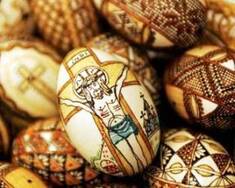
But the Medieval folks did more than eat them. They also painted them and rolled them down low hills as a game. The practice of painting eggs dates far back in history when decorated shells were part of the rites of spring. One source said these were Ostrich eggs, which probably applied to eastern Christians, rather than Europeans.
“Early Christians of Mesopotamia painted them red to symbolize the blood of Christ. The Medievalist Errant notes, “In 1276, Eleanor and Simon de Montfort bought 3700 eggs for their celebration, and in 1290 Edward I’s accounts show that he paid to have 450 eggs decorated with gold leaf.” Eggs were hidden for children to find as an allegory for the disciples finding the risen Christ in the tomb on Easter morning."
https://aethelmearcgazette.com/2015/04/05/medieval-easter-traditions/
Other accounts claim that hiding eggs was a German practice that didn’t come about until the 1700’s. Germans painted them green and hung them on trees.
“Hock” Monday, the day after Easter, young women would “capture” young men and not release them until they made a donation to the church. On “Hock” Tuesday the young men would capture the girls. I’m not sure this practice exists today.
There are places still where the day after Easter is a holiday as well, but for most of us, it’s back to work or school.
So all in all, there isn’t much difference between the medieval celebrations and our own, except for the Easter Bunny phenomenon which is another whole blog -- and just as controversy as everything else.
Just Sayin’
□
Sources:
https://aethelmearcgazette.com/2015/04/05/medieval-easter-traditions/
https://medievalisterrant.wordpress.com/2013/03/29/medieval-easter-traditions/
https://medievalisterrant.wordpress.com/2013/03/29/medieval-easter-traditions/
https://www.tor.com/2019/04/19/the-medieval-origins-of-easter-traditions/
https://www.history.com/topics/holidays/history-of-easter
https://www.goodhousekeeping.com/holidays/easter-ideas/g191/history-easter-traditions/
https://en.wikipedia.org/wiki/Easter
https://www.britannica.com/topic/Easter-holiday
http://ww1.antiochian.org/node/17394
https://christianhistoryinstitute.org/magazine/article/worship-in-the-supposed-dark-ages/
https://en.wikipedia.org/wiki/History_of_Christianity#Early_Christianity_(c._31/33%E2%80%93324)
organicfeeds.com/how-long-can-fresh-backyard-chicken-eggs-last/
https://www.ancient.eu/article/1205
https://www.christianitytoday.com/history/issues/...
https://merovingianworld.com/2015/04/03/easter-and-co-ordinating-time-in-the-early-middle-ages/#:~:text=In%20the%20early%20Middle%20Ages%2C%20as%20Roman%20imperial,portion%20of%20the%20rest%20of%20the%20liturgical%20calendar.
https://themiddleagesportfolio.weebly.com/medieval-food-and-feasts.html#:~:text=Some%20types%20of%20food%20that%20were%20traditionally%20served,plums%20and%20pomegranate%20seeds%20covered%20in%20German%20sauce.
https://realfoodforager.com/recipe-purple-pickled-eggs/#:~:text=Pickled%20eggs%20were%20popular%20in%20the%20middle%20ages,rage%20in%20pubs%20and%20bars%20until%20the%201970%E2%80%99s.
Sources of Photos/ images
https://aethelmearcgazette.com/2015/04/05/medieval-easter-traditions/
https://www.tor.com/2019/04/19/the-medieval-origins-of-easter-traditions/
https://commons.wikimedia.org/w/index.php?curid=313273
https://commons.wikimedia.org/wiki/File:P%C3%B6tting_Kirchenfenster_7_Osterlamm.jpg
https://commons.wikimedia.org/w/index.php?curid=3200390
https://commons.wikimedia.org/w/index.php?curid=313273
https://commons.wikimedia.org/w/index.php?curid=8724640
https://www.thriftbooks.com/w/a-history-of-the-english-church-and-people_bede/282805/item/1238888/?mkwid=Vp0rZzwJ%7cdc&pcrid=11558858428&pkw=&pmt=be&slid=&product=1238888&plc=&pgrid=3970769502&ptaid=pla-1101002859940&utm_source=bing&utm_medium=cpc&utm_camp
https://www.wattpad.com/237404088-the-goddess-eostre-eostre-and-eos
https://www.slideserve.com/zachary-dean/christians-in-the-3rd-4th-century-constantine
https://steel-mastery.com/middle-ages-women-s-clothing.html
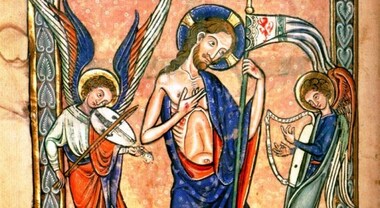
 RSS Feed
RSS Feed